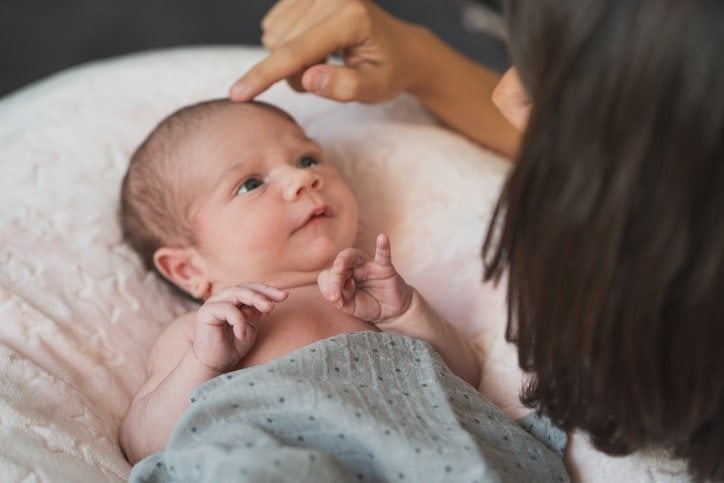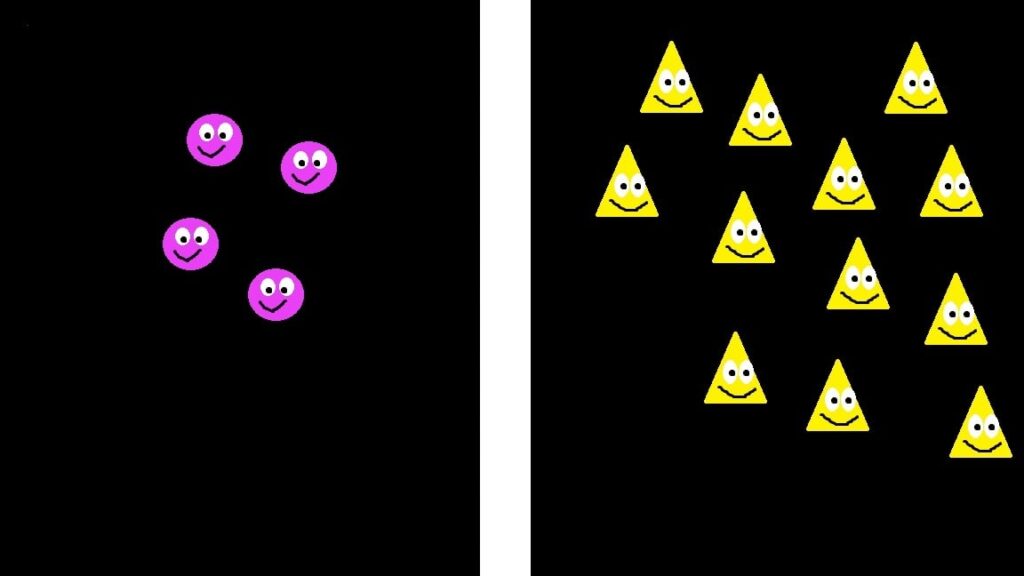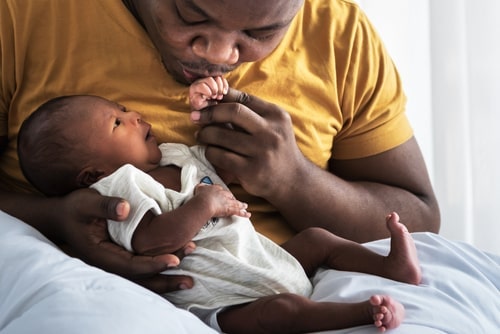What do newborns think about? During the first few weeks after birth, it might seem that your baby does little more than sleep, cry, and feed. But research tells us otherwise.

The newborn brain is busy processing information, searching for patterns, and learning. Here’s a fascinating look at newborn cognitive development, covering these topics:
- how newborns can recognize your voice (and certain music, too);
- what newborns are learning about language;
- the special interest that babies show in faces and biological movement, and their remarkable ability to use touch to figure out what an unseen object looks like;
- newborns’ rudimentary sense of number or quantity;
- the case for a degree of consciousness or self-awareness in newborns; and
- evidence that newborns can learn during sleep.
For additional information about the mind of your newborn, see my guide to newborn sensory perception, as well the many Parenting Science articles mentioned below.
Even before birth, babies have begun paying attention to sound. And newborns can recognize familiar voices and tunes!
Late in gestation, babies are already paying attention to the sounds they hear. How do we know? Ultrasound studies. When these babies hear their mothers’ voices, they alter their behavior and experience changes in heart rate — as if they are attending to, or processing, the sounds they hear (Kisilevsky et al 2009; Voegtline et al 2013; Lee and Kisilevsky 2014; Kisilevsky and Hains 2011). So it appears begin listening to us even before they are born. Do they learn anything? Yes.
Newborns can recognize their mother’s voices
What happens if a newborn listens to audio recordings — one featuring the voice of an unfamiliar woman, the other featuring the voice of the baby’s own mother? Multiple studies report the same pattern. Babies respond differently depending on whose voice they hear (Ockleford et al 1988; Beauchemin et al 2011; Lang et al 2020).
Moreover, the difference matters to babies. They prefer to listen to their own mothers.
How can we tell? In a pioneering experiment, Anthony DeCasper and William Fifer gave 12-hour-old newborns the power to start and stop the audio playbacks. Each infant was given a pacifier (or “dummy”) to suck on, and if a baby wanted to continue hearing a voice, the baby needed merely to keep sucking. To stop a story, babies had to pause sucking for two seconds or more.
As you might expect, it took the babies a few minutes to figure this out, but once they did, they showed a clear preference: They “voted” to spend more time listening to their mothers (DeCasper and Fifer 1980).
[And — by the way — research suggests that a mother’s voice can soothe pain, reduce stress, and even enhance an infant’s ability to process language. For more information, see my article, “How do children respond to a mother’s voice?”]
Newborns may recognize certain melodies, too
Suppose you keep playing the same melody during pregnancy — multiple times a week. Will your baby remember this tune later, after birth? Researchers tested the idea by assigning women who were 29 weeks pregnant to engage in regular listening sessions with some music on CD.
The CD included the melody of “Twinkle, Twinkle, Little Star,” and — many times each week — women played back the recording at a volume comparable to someone singing about three feet away from their bellies. The listening sessions continued until just before each baby was born, with babies hearing the melody (on average) about 170 times total.
Then, shortly after childbirth, the researchers played “Twinkle, Twinkle” to the newborns. It was the first time the babies encountered the melody outside their mothers’ wombs, and their brain activity was monitored using electroencephalography (EEG). For purposes of comparison, the research team conducted the same test on a control group — newborns who hadn’t been subjected to prenatal music sessions.
What happened? The babies showed neural signs of being familiar with the tune. The control group babies did not (Partanen et al 2014). And these findings are consistent with other experimental research (reviewed by Movelled et al 2023).
What about language?
Newborns can recognize the distinctive sounds of their parents’ native language

Babies are born with knowledge of the voices and music they’ve overheard during gestation. Might they also know something about the languages that their mothers speak? Christine Moon and her colleagues used the previously-mentioned “pacifier technique” to find out.
There were 80 newborns total — infants average just 33 hours hold. Half were from families that spoke only Swedish; half from families that spoke only English. And all babies heard playbacks of vowel sounds from both languages: Swedish and English.
Once again, babies could control what they heard by sucking on a pacifier. If a baby kept sucking, he or she would continue to hear the same vowel sound repeated over and over again. If a baby stopped sucking, the audio playback would move onto a new vowel sound.
In this way, the researchers could determine if the babies distinguished between vowel sounds. By repeated sucking, a baby was in effect saying “Hmm, that’s interesting. Let me hear that one again.”
When Moon and her team analyzed the results, they found that babies in both countries sucked on their pacifiers more when they heard foreign vowel sounds. It was as if the babies noticed something unusual and wanted to investigate. Newborns seemed motivated to expose themselves to new language data (Moon et al 2013).
Newborns can also pick out individual words from a stream of speech
On the written page, it’s easy to identify individual words. They are separated by physical space. But spoken language is different. It’s often a continuous flow of sound, with no obvious markers between words.
So anyone attempting to learn a new language faces a big challenge. Where does one word end, and another begin? Amazingly, it appears that babies have already begun working on this problem within a few days of birth. In a recent study using brain imaging technology, researchers found that 3-day-old babies could pick out individual words from a stream of continuous speech (Fló et al 2019).
How did the babies do it? The researchers think two methods are likely.
First, newborns are probably relying on “prosodic” features of speech, such as changes in pitch, rhythm, and stress. Newborns seem to use these features as cues for detecting word boundaries.
Second, it appears that newborns are also noticing statistical associations — tracking common patterns in the way that a language combines sounds to make words. For instance, with enough data, a baby listening to English might notice that most words end in consonants.
So newborns aren’t just letting language wash over them. Their brains are trying to make sense of it. And they do something else that helps them learn…
Newborns pay special attention when we speak to them in the exaggerated, melodic register known as “infant-directed speech”
It happens to parents all over the world: We automatically change our speech patterns when we address a baby. And experiments show that babies actively prefer to be addressed this distinctive way. It really captures their attention, and helps them understand our emotional intentions.
Moreover, certain features of infant-directed speech make it easier for babies to decode new words. You can read more about infant directed speech in my articles,
- Better baby communication: Why your baby prefers infant-directed speech, and
- Baby talk 101: How infant-directed speech helps babies learn language.
What do newborns understand about the visual world?
As I explain in my article about the newborn senses, young babies can’t see very well. Their vision is blurry, and they haven’t yet developed good depth perception.
But newborns are nevertheless very interested in the sights around them — particularly in sights that suggest biological movement.
For instance, if you show newborns a swarm of moving points of light, their attention depends on how the points move.
Make each point move in its own, random way, and babies are less interested. Make all the points move together in the same direction (what scientists call “point-light biological motion”), and newborns really take notice (Bidet-Ildei et al 2014). It seems an effective rule of thumb for identifying living creatures: Pay attention to the stuff that moves as a unit.
In addition, newborn babies pay special attention to faces
For example, newborns show a bias for looking at faces and face-like imagery. And they respond differently to faces depending on social cues. They tend to stare longer at happy faces — particularly if the person in question is looking the baby in the eye (e.g., Rigato et al 2011; Guellaï et al 2020). They also show evidence of being able to distinguish between rather similar looking facial expressions — a squinting, cheerful grin and a squinting grimage of disgust (Addabbo et al 2018).
Moreover, newborns can quickly learn to tell one person’s face from another’s. In one experiment, newborn babies were capable of recognizing a specific face after just 90 seconds of looking (Coulon et al 2011)!
Does this mean that newborns recognize their parents’ faces?
You bet. Learn more about this and other social feats in my article, “The social world of newborns.”
Newborns can also visualize unseen objects — objects they have explored only via their sense of touch!
Suppose you are blindfolded, and I hand you an object. You investigate it with your hands. Can you imagine what it must look like?
I’m betting you’d be pretty good at visualizing its basic contours. But of course you’ve had a lifetime of experience — touching objects and looking at them. What if you were a very young baby? A newborn who hasn’t seen much of anything yet?
Arlette Streri and her colleagues have a procedure for testing this ability in newborns, and it goes like this:
- Put a three-dimensional shape (such as a small cylinder) in a newborn’s hand, taking care to make sure the baby can’t see it.
- When the baby drops the object, place it back in the infant’s hand. Repeat several times so that the baby has plenty of opportunity to become familiar with the way the object feels.
- Once the baby is familiar with tactile properties of the object, test the baby for visual recognition: Show the baby two objects — only one of which is a match for the object that the baby held. Then measure how much time the baby spends looking at each object.

When Streri and her colleagues tried this, they found that newborns would look longer at the shape they hadn’t touched before, as if it was less familiar (and thus more interesting).
Moreover, newborns showed this preference despite the fact that the visual test stimuli were much larger versions of the objects they actually held. So newborns hadn’t become familiar merely with the specific objects they’ve handled. They’d become familiar with their shapes – in the abstract.
Similar experiments show that newborns can anticipate what different textures will look like. If they handle an (unseen) object with a bumpy texture, they later act as if they are familiar with the visual appearance of that texture. Somehow, without practice, the newborn brain knows how to translate tactile information into visual information (Streri et al 2013).
Do newborns possess an abstract notion of quantity?
Newborn infants can’t count, of course. But experiments tell us that newborns can look at different quantities of dots or shapes, and distinguish between, say, 4 objects and 12 objects.
That alone is pretty cool. But there’s more. Newborns can also apply this rudimentary number sense to sets of sounds, such as spoken syllables (4 repetitions of “ra” versus 12 repetition of “ra”). Moreover, they can match up auditory quantities with visual ones. If they hear 4 syllables, they will likely connect this experience with seeing 4 objects (and not 12).
For example, let’s suppose we play an audio recording of someone repeating the same syllable (“ra”) four times in a row. After this person says the fourth “ra,” she pauses a second, and then she starts over again. This audio recording keeps on looping while the baby listens.
Meanwhile, we show the baby a series of animated video clips. Each clip depicts a number of googly-eyed shape-creatures. Sometimes all of the creatures on the screen are circles. Other times they are triangles…or hearts…or diamonds…or squares. They vary in color as well — from one clip to the next — and all shape / color combinations are randomized. But exactly half of the video clips that newborns watch depict a total of 4 on-screen characters, and the other half depict 12.

When Veronique Izard and her colleagues have performed such experiments, they’ve found that babies look longer at video clips that match up numerically with audio clips.
If the babies hear the syllables repeated 4 times in row, they spend more time looking at the video clips with 4 characters. If they hear 12 repetitions of the syllable, they linger longer on the video clips showing 12 characters (Izard et al 2009).
How are newborns doing this “cross-modal matching”? What’s going on in their heads?
We can’t know for sure, but we know they aren’t fixating on any particular shape or color. The results were the same for all combinations.
It’s also clear that there are limits to this quantity-comparison ability. To make the connection between sounds and visual arrays, the difference between sets needs to be pretty big — a ratio of 1:3 or more. And sets to be larger than 2. When researchers tested a contrast of 2 versus 6, newborns looked longer at clips of 6 creatures — regardless of how many syllables they heard (Coubart et al 2014).
So this is a very rough sense of number, and it doesn’t seem to really “click” unless newborns are comparing larger sets that vary by a big ratio — 3 versus 9, 4 versus 12, 6 versus 18.
Yet however you slice it, it appears that newborns are representing something abstract about the sounds they hear — their quantity. Then they are applying this concept to the objects they see. It’s similar to what researchers observed in the experiments about touching unseen objects: Newborns represented something abstract about the objects they touched (three-dimensional shape) and then used that abstract property to recognize other objects by sight.
This must be very helpful for learning about the postpartum world. Instead of having to learn about every experience or event in isolation, newborns notice higher order properties that apply across the board. They generalize. As the researchers of these studies conclude, this ability may be “a necessary prerequisite for the development of knowledge in infancy” (Streri et al 2013).
Are newborns conscious? Are they self-aware?
Obviously, newborns are missing many of the abilities and experiences that characterize adult consciousness. They don’t use language, and they have an extremely limited knowledge of the world. They can’t draw on a library of autobiographical memories.
But that doesn’t mean that babies are unconscious. On the contrary, newborns show signs of having what researchers call “basic” or “core” consciousness (Lagercrantz and Changeux 2010; Hu et al 2022).

As we’ve seen, these babies show biases for attending to important social signals — like voices, faces, and purposeful movements. And experiments indicate that newborns can tell the difference between sounds of their own cries from the cries of other babies (Martin and Clark 1987; Simner 1971).
In addition, there is evidence that newborns possess a sense of bodily awareness — recognizing that their body parts “belong” to them (Filippetti et al 2013; Bahrick 2013).
Moreover, brain scan research (using fMRI) hints that newborns have the necessary equipment to generate conscious experiences
To see what I mean, consider how things work in adults. Brain scan studies reveal that distinct brain circuits become more active depending on what we’re consciously thinking about.
- When we’re attending to external, sensory stimuli, we experience heightened activity in two networks — the dorsal attention network (DAN) and the executive control network (ECN).
- When we’re daydreaming or introspecting, we show increased activity in the default mode network (DMN).
And here’s an important wrinkle: Our brains don’t activate all these networks at once. Scan the brain of a conscious adult, and she’ll either show lots of activity in the DAN and ECN, or she’ll have a party going on in the DMN. If the adult isn’t following this pattern, it’s a sign that she’s unconscious — either because she’s been drugged for surgery, or because she has suffered serious brain damage (Hu et al 2022).
So the question is…does newborn brain circuitry look like the brain circuitry of conscious adults? Hiquing Hu and her colleagues performed scans on more than 250 newborn babies to find out.
They confirmed that all three of the networks are present at birth, although one of them — the executive control network — was less developed than the others. And the other two show the reciprocal pattern of activity that is linked with consciousness in adults: When the dorsal attention network (DAN) was highly active, the default mode network (DMN) was inactive (and vice versa).
Interestingly, babies born prematurely didn’t show these patterns at all, not until they reached the equivalent age of a full-term newborn. As Hu’s team concludes, this suggests that full-term neonates have the capacity “to integrate sensory and incipient cognitive experiences into coherent concious experiences about their core self and the developing relationship to their environment” (Hu et al 2022).
Newborns can learn during sleep!
Despite what you may have heard, there is little or no scientific evidence that adults can learn new things while they sleep. But newborns? That’s another story (Callahan and Fifer 2021).
For example, researchers have tried blowing puffs of air onto the eyelids of sleeping newborns. It makes the babies’ facial muscles twitch, but what’s interesting is that these babies can learn to anticipate. Before each puff of air, the researchers play a brief auditory tone. And, after repeated trials, the newborns begin to twitch in response to the tone itself (Fifer et al 2010).
What about other sorts of learning — like learning about language? Do sleeping newborns hear us when we speak? Do their brains process the information?
Once again, the answer is yes. For instance, experiments indicate that newborns can learn to discriminate between different vowel sounds while they are sleeping (Cheour et al 2002). They can also learn to find some of those boundaries between words (Teinonen et al 2009; Fló et al 2019; Benjamin et al 2023).
More about cognitive development in newborns and older babies
As noted above, my article, “The social world of newborns” reviews more fascinating evidence about your baby’s abilities. In addition, you can learn about other aspects of infant cognitive development from these Parenting Science articles:
- Can babies sense your stress?
- Can babies sign before they speak?
- Can babies tell when parents are fighting?
- Do babies feel empathy?
- Do babies know right from wrong?
- Talking to babies
- What do babies know about numbers?
- When do babies speak their first words?
References: Newborn cognitive development
Addabbo M, Longhi E, Marchis IC, Tagliabue P, Turati C. 2018. Dynamic facial expressions of emotions are discriminated at birth. PLoS One. 13(3):e0193868.
Bahrick LE. 2013. Body perception: intersensory origins of self and other perception in newborns. Curr Biol. 2013 Dec 2;23(23):R1039-41.
Beauchemin M, González-Frankenberger B, Tremblay J, Vannasing P, Martínez-Montes E, Belin P, Béland R, Francoeur D, Carceller AM, Wallois F, Lassonde M. 2011. Mother and stranger: an electrophysiological study of voice processing in newborns. Cereb Cortex. 21(8):1705-11.
Benjamin L, Fló A, Palu M, Naik S, Melloni L, Dehaene-Lambertz G. 2023. Tracking transitional probabilities and segmenting auditory sequences are dissociable processes in adults and neonates. Dev Sci. 26(2):e13300.
Bidet-Ildei C, Kitromilides E, Orliaguet JP, Pavlova M, Gentaz E. 2014. Preference for point-light human biological motion in newborns: contribution of translational displacement. Dev Psychol. 50(1):113-20.
Callaghan B and Fifer WP. 2021. Perinatal attention, memory and learning during sleep. Enfance. 69(3):349-361.
Cheour M, Martynova O, Näätänen R, Erkkola R, Sillanpää M, Kero P, Raz A, Kaipio ML, Hiltunen J, Aaltonen O, Savela J, Hämäläinen H. 2002. Speech sounds learned by sleeping newborns. Nature. 415(6872):599-600.
Coubart A, Izard V, Spelke ES, Marie J, Streri A. 2014. Dissociation between small and large numerosities in newborn infants. Dev Sci. 17: 11–22.
Coulon M, Guellai B, Streri A. 2011. Recognition of unfamiliar talking faces at birth. Int. J. Behav. Dev. 35:282–287.
DeCasper AJ and Fifer WP. 1980. Of human bonding: newborns prefer their mothers’ voices. Science. 208(4448):1174-6.
Fifer WP, Byrd DL, Kaku M, Eigsti IM, Isler JR, Grose-Fifer J, Tarullo AR, Balsam PD. 2010. Newborn infants learn during sleep. Proc Natl Acad Sci U S A. 107(22):10320-3.
Filippetti ML, Johnson MH, Lloyd-Fox S, Dragovic D, Farroni T. 2013. Body perception in newborns. Curr Biol. 2013 Dec 2;23(23):2413-6.
Fló A, Brusini P, Macagno F, Nespor M, Mehler J, Ferry AL. 2019. Newborns are sensitive to multiple cues for word segmentation in continuous speech. Dev Sci. 22(4):e12802.
Guellaï B, Streri A, Chopin A, Rider D, Kitamura C. 2016. Newborns’ sensitivity to the visual aspects of infant-directed speech: Evidence from point-line displays of talking faces. J Exp Psychol Hum Percept Perform. 42(9):1275-81 2016.
Háden GP, Mády K, Török M, Winkler I. 2020. Newborn infants differently process adult directed and infant directed speech. Int J Psychophysiol. 147:107-112.
Hepper PG. 1991. An Examination of Fetal Learning Before and After Birth. Irish Journal of Psychology. 12: 95-107.
Hu H, Cusack R, Naci L. 2022. Typical and disrupted brain circuitry for conscious awareness in full-term and preterm infants. Brain Commun. 4(2):fcac071
Izard V, Sann C, Spelke ES, Streri A. 2009. Newborn infants perceive abstract numbers. Proceedings of the National Academy of Sciences of the United States of America. 106(25):10382–10385.
Kisilevsky BS and Hains SM. 2011. Onset and maturation of fetal heart rate response to the mother’s voice over late gestation. Dev Sci. 14(2):214-23.
Kisilevsky BS, Hains SM, Brown CA, Lee CT, Cowperthwaite B, Stutzman SS, Swansburg ML, Lee K, Xie X, Huang H, Ye HH, Zhang K, Wang Z. 2009. Fetal sensitivity to properties of maternal speech and language. Infant Behavior & Development. 32:59–71.
Lang A, Ott P, Del Giudice R, Schabus M. 2020. Memory Traces Formed in Utero-Newborns’ Autonomic and Neuronal Responses to Prenatal Stimuli and the Maternal Voice. Brain Sci. 10(11):837.
Lagercrantz H and Changeux JP. 2010. Basic consciousness of the newborn. Semin Perinatol. 34(3):201-6
Lee GY and Kisilevsky BS. 2014. Fetuses respond to father’s voice but prefer mother’s voice after birth. Dev Psychobiol. 2014 Jan;56(1):1-11.
Mampe B, Friederici AD, Christophe A, Wermke K. 2009. Newborns’ cry melody is shaped by their native language. Curr Biol. 19(23):1994-7.
Martin GB and Clark RD. 1987. Distress crying in neonates: Species and peer specificity. Developmental Psychology 18: 3-9.
Marx V and Nagy E. 2015. Fetal Behavioural Responses to Maternal Voice and Touch PLoS One. 10(6):e0129118.
Moon C, Lagercrantz H, Kuhl PK. 2013. Language experienced in utero affects vowel perception after birth: a two-country study. Acta Paediatr. 102(2):156-60.
Movalled K, Sani A, Nikniaz L, Ghojazadeh M. 2023. The impact of sound stimulations during pregnancy on fetal learning: a systematic review. BMC Pediatr. 23(1):183.
Ockleford EM, Vince MA, Layton C, Reader MR. 1988. Responses of neonates to parents and others voices. Early Hum Dev. 18(1):27–36.
Partanen E, Kujala T, Tervaniemi M, Huotilainen M. 2013. Prenatal music exposure induces long-term neural effects. PLoS One. 8(10):e78946.
Rigato S, Menon E, Johnson MH, Faraguna D, and Farroni T. 2011. Direct gaze may modulate face recognition in newborns. Infant and Child Development 20(1): 20–34.
Sambeth A, Ruohio K, Alku P, Fellman V, Huotilainen M. 2008. Sleeping newborns extract prosody from continuous speech. Clin Neurophysiol. 119(2):332-41.
Simner, M. L. (1971). Newborn’s response to the cry of another infant. Developmental Psychology, 5(1), 136–150.
Streri A, de Hevia M, Izard V, Coubart A. 2013. What do we Know about Neonatal Cognition? Behav Sci. 2013; 3: 154–169.
Teinonen T, Fellman V, Näätänen R, Alku P, Huotilainen M. 2009. Statistical language learning in neonates revealed by event-related brain potentials. BMC Neurosci. 10:21.
Voegtline KM, Costigan KA, Pater HA, DiPietro JA. 2013. Near-term fetal response to maternal spoken voice. Infant Behav Dev.36(4):526-33.
Content last modified 5/5/2023. Portions of the text derive from an earlier version of this article, written by the same author.
Image credits for “Newborn cognitive development”
title image of of baby staring at mother who is touching the baby’s forehead by istock /MJPS
image of baby squinting and touching mother by shutterstock / Amorn_Suriyan
image of orange cylinder and prism by Parenting Science
image of googly-eyed shapes by Parenting Science; graphic is inspired by experimental illustrations published by Izard et al 2009 (full citation above)
image of father kissing baby’s hand by Anatta_Tan / shutterstock